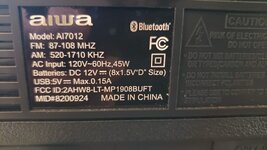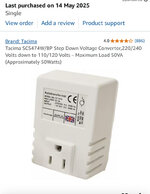You may have a defective power supply inside or a blown fuse. I'm not accusing you of accidentally plugging it into a 220V outlet, but if that ever happened, it would certainly blow a fuse at the very least. More than likely, I believe the radio was supplied the correct voltage through your converter, but I suspect that it did not feed the correct frequency.
I was looking at your converter specs. While it does show 50/60Hz input/output, I am willing to bet that all that is is a transformer. Which means, if you feed it 220/240V at 50Hz, it will output 110/120V at 50Hz. But if you feed it 220/240V at 60Hz it will output 110/120V at 60Hz. I doubt it actually changes frequency. Normally most brand name electronics would not care because their power supplies are rated and show 50/60Hz. This boombox does not which makes me question whether its safe to feed it 50Hz. If it is not designed to handle 50Hz, a 60Hz device will run hot, possibly overheat and may blow a fuse or result in damage. Seeing as that it plays on batteries, whatever your issues are, it's limited to the power supply inside likely.
A few tests can be performed though. Do you have the factory plug for your boombox? The boombox side of the power cord should be flat on one side and round on the other. Sometimes if the wrong power cord is/was supplied or used, it will not operate the switch in the AC socket properly and/or make a good connection to the pins inside the power cord. If you have other power cords that you could try, that would eliminate that possibility. There is a switch in the AC socket that switches from battery to AC when you put the power cord in. You could verify the switch is working by not plugging the radio's power cord into an outlet. Simply plugging it into the AC socket on the back of the boombox with the radio playing on batteries with the AC switch in the on position should result in the radio turning off. If this happens you know the switch is being operated by the cord correctly. Next plug the cord into a converter supplying the correct voltage and frequency (120V / 60Hz). The transformer is at the top left of the boombox. If you put your ear to the top left cover, you should hear it humming. If so, you know power is reaching the transformer. If not, then either the power is not reaching the transformer due to a bad connection with the power cord, or you have an internal fault that is going to require service. All this can be done without even removing a screw and would help diagnose your issue. If it is humming, then you have an issue with the A/C to DC converter (bridge rectifier circuit) after the transformer. Could be as simple as a fuse or faulty components (diodes, etc.).
Hope this helps



